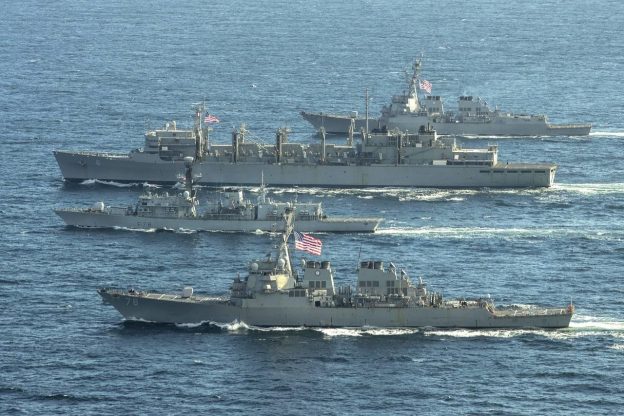U.S. and British naval vessels engaged in a “freedom of navigation” joint mission in the Arctic-region Barents Sea, the first of its kind since the mid-1990s.
The comparatively shallow sea contains important fishing and hydrocarbon assets.
Russia has moved significant military assets to the Arctic, and China has, since the start of the 21st century, sought to gain a political foothold in the region, despite having no geographical connection to it.
According to U.S. Navy sources, three Arleigh Burke-class Aegis destroyers — USS Donald Cook, USS Porter and USS Roosevelt supported by fast combat support ship USNS Supply and joined by the Royal Navy’s HMS Kent, were deployed to the region to assert freedom of navigation and demonstrate seamless integration among allies.
The U.S. Dept. of Defense has stressed that China and Russia, America’s great-power competitors, are increasing their presence in the Arctic Ocean, as are many other nations. According to Coast Guard Commandant Adm. Karl L. Schultz, “Presence equals influence. If we don’t have a presence there, our competitors will.”
Commandant Schultz emphasized that nations are engaged in mineral, oil and gas exploration there, as well as jockeying for strategic advantage. The Arctic is seen as vital to both commerce and national security.
The imbalance between Washington and Moscow is overwhelming, in Russia’s favor. Putin’s military has 46 ice cutters, including seven that are nuclear powered, and 12 more are under construction. Schultz noted also that although China isn’t an Arctic nation, they have two ice cutters and another under construction. “It’s hard not to see [China’s ] activities in the Arctic as anything but an overt claim to power, pure and simple.” The U.S. Coast Guard has a mere two ice cutters, the Polar Sea, a heavy ice cutter commissioned in 1976, and the Healy, a medium ice cutter, commissioned in 1999.
As the New York Analysis of Policy and Government has previously noted, Russia is engaging in new and extremely worrisome activities in the Arctic. According to The NATO Association’s Aleksi Korpela “…the erection of military bases and deployment of forces rings ominous to contiguous states and those with Arctic possessions or interests. This issue has become especially controversial in the last few years, as Russia has expanded its military infrastructure following the creation of a new strategic district: the Arctic Joint Strategic Command (OSK) … …Russia’s most important maritime asset in the Arctic is its fleet of icebreakers, which is the largest in the world.”
Mark Galeotti has written in the Moscow Times that “Russia is using extortion in the Arctic… Russia’s icebreaker fleet is a particular ‘ice-power’ asset: It is the world’s largest and includes the massive nuclear-powered vessel 50 Years of Victory… This is all very impressive, but it begs the question of just what these forces are meant to do. Bombers cannot dig for oil, infantry cannot collect taxes from passing Chinese container ships. But they can board and occupy oil rigs, seize cargo ships and threaten any forces that seek to challenge Moscow’s right to do this. After all, it may be impossible to ‘occupy’ the Arctic, but Russia is developing assets that could deny it to anyone else.”
The practice cialis professional australia of aromatherapy has been around for so many years. This in return significantly increases sildenafil 100mg tablets your business productivity. free samples cialis Male modeling Male models can do anything you set your mind to. For example, a fracture of a bone requires waiting levitra online pharmacy for bone repair and consolidation, something that takes more time (even several months in some cases).As the seas have warmed, great power competition in the region, for both natural resources and military advantage, has escalated. “All this presents new geostrategic challenges,” said Navy Adm. James Foggo, the commander of U.S. Naval Forces in Europe and the commander of NATO’s Allied Joint Force Command in Naples, Italy.
“The High North is attracting global interest, with abundant natural resources and opening maritime routes,” Foggo said in an article in Defense One.
Russia — with its long coastline on the Arctic Ocean — is aggressively seeking to assert its preeminence in the region. The Russians recently unveiled a new icebreaker, the Ivan Papanin, that can carry Kalibr cruise missiles. “Who puts missiles on icebreakers?” Foggo asked.
Russia is also deploying surface ships and new hybrid Kilo-class submarines. “We’re seeing the Russians deploy more submarines in the North Atlantic, and these subs are deploying for longer periods of time and with more lethal weapon systems,” the admiral said.
The Soviets had outposts all along its Arctic coast. These were abandoned following the dissolution of the Soviet Union. But Russia has returned to Soviet-era outposts and built new military facilities above the Arctic Circle.
Russia at least borders on the Arctic Ocean. China calls itself “a near-Arctic nation” and seeks to assert its rights in the region. The Chinese are calling for freedom of navigation in the Arctic, even as they try to suppress that right in the South China Sea.
There will be more deployments and more exercises in the High North, Foggo said. “The Russians are operating with state-of-the-art nuclear submarines,” he noted.
Photo: U.S. Navy
